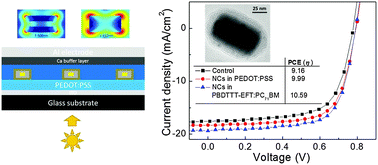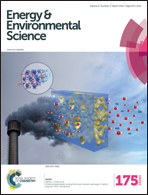Au/Ag core–shell nanocuboids for high-efficiency organic solar cells with broadband plasmonic enhancement†
Abstract
Although various metal nanoparticles have been used in organic photovoltaics (OPVs) for enhancing power conversion efficiencies (PCEs) based on surface plasmonic effects, no metal nanoparticles have been found to induce matchable broadband plasmonic enhancement in OPVs until now. Here, we report the introduction of Au@Ag core–shell nanocuboids (NCs) with broadband plasmonic enhancement in OPVs for the first time. The Au@Ag NCs show multimode localized surface plasmon resonance that can be tuned to match the light absorption spectra of OPVs by changing the Ag shell thickness. We find that both light scattering and near field enhancement induced by the NCs can substantially improve the device performance when the NCs are incorporated in the active layers. Under optimum conditions, the PCEs of the OPVs can be relatively improved by up to 22.8% by the NCs. The maximum average PCE of the OPVs we obtained is 10.42%, which is much higher than those of the previously reported plasmonic OPVs. This work demonstrates a convenient approach for improving the photovoltaic performance with broadband enhancement, which is applicable to not only OPVs but also many other types of solar cells.


 Please wait while we load your content...
Please wait while we load your content...